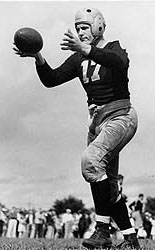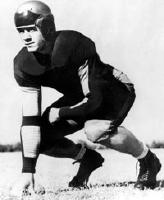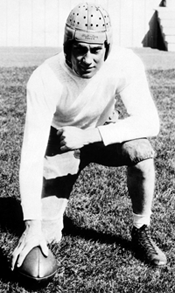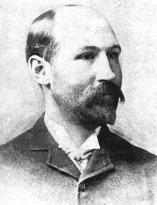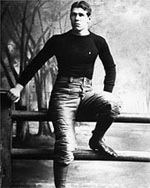 William "Pudge" Heffelfinger |
The first professional football player was William "Pudge" Heffelfinger. He was paid $500 by the Allegheny Athletic Association on November 12, 1892 to play against the rival Pittsburgh Athletic Club. The money was well spent as AAA defeated PAC that day.
The 6'2 2/3" 205 lb Heffelfinger was the greatest star of the day, having just finished four years at Yale, where he made All-American three times. It helped that his coach, Walter Camp, named the all-star team each year, but no one disputed that the Minneapolis-born Pudge belonged on it. While various athletic clubs had for years remunerated top players by various means, such as paying expenses twice or awarding an expensive watch that the player could pawn, the AAA's contract with Heffelfinger is the first one on record that specifically states a cash amount for his participation. |
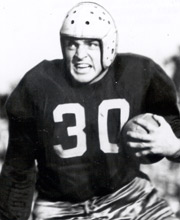 Clark Hinckle
|
The first NFL post-season All-Star game was played on January 15, 1939, at Wrigley Field – not the one in Chicago but the other baseball park in Los Angeles. The league champion New York Giants played a team composed of players from the other NFL teams and two Pacific Coast Professional Football League clubs. The Giants won 13-10.
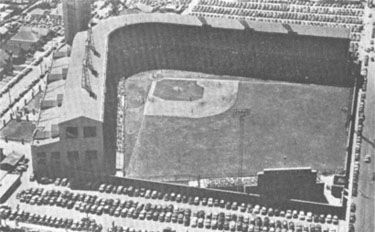 Wrigley Field, Los Angeles Fewer than 15,000 attended the contest, whose proceeds went to charity. The game was also considered an opportunity for the City of Angels to show that it deserved consideration for an NFL franchise.
Called "the greatest collection of stars ever gathered at one time," the All-American team included:
New York countered with Ed Danowski, Mel Hein, Ward Cuff, Hank Soar, and Ed Widseth. Giants owner Tim Mara expressed disappointment in the turnout. "They told me the game would turn the customers away, and I believed 'em. So I brought the team out and the game cost me plenty of money, not to mention the tough afternoons I had at Santa Anita [race track]." |
 Ed Danowski
|
|
The first televised football game took place on September 30, 1939. Waynesburg College of Pittsburgh visited powerful Fordham University at Triboro Stadium on Randall's Island in New York City.
NBC telecast the game on its experimental station W2XBS based in the Empire State Building. The range of the broadcast was approximately 50 miles to a potential audience of about 100 TV sets. So Waynesburg fans in Pittsburgh could not receive the telecast even if they had a set. Many viewers watched on monitors while visiting the RCA Pavilion at the World's Fair in New York. NBC used only one camera, which was stationed on the sideline. Famous radio sportscaster Bill Stern did the play-by-play. Waynesburg's Bobby Brooks entered the sports history books by running 63y for the first televised TD. However, that was it for the visitors as Fordham won 34-7.
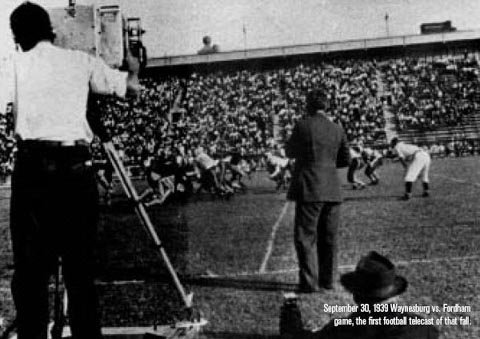 Michael "Mo" Scarry, later a defensive line coach for the Miami Dolphins, was one of the Waynesburg players. According to Scarry, "some of the early guys going into the game — half of them stumbled or fell over the wires."
|
The first televised professional football game took place on October 22, 1939, at Ebbets Field, Brooklyn. The Brooklyn Dodgers of the NFL defeated the Philadelphia Eagles 23-14 before a crowd of 13,050. NBC telecast the game on its experimental station W2XBS based in the Empire State Building. The range of the broadcast was approximately 50 miles to a potential audience of about 100 TV sets. Many viewers watched on monitors while visiting the RCA Pavilion at the World's Fair in New York. NBC utilized two iconoscopic cameras – one in the box seats on the 40-yard line and the other in the mezzanine section. The announcer was Skip Walz.
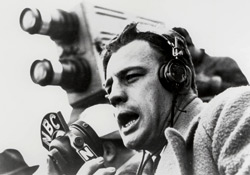 Skip Walz Walz had no monitor to show him what the audience was watching. "I'd sit with my chin on the rail in the mezzanine, and the camera was over my shoulder. I did my own spotting, and when the play moved up and down the field, on punts or kickoffs, I'd point to tell the cameraman what I'd be talking about."
The game began at 2:30 p.m. and ran for two hours and thirty-three minutes. Of course, there were no commercial interruptions during the 1939 game. There were, however, interruptions of another sort. "It was a cloudy day. When the sun crept behind the stadium, there wasn't enough light for the cameras," remembered Walz. "The picture would get darker and darker, and eventually it would go completely blank, and we'd revert to a radio broadcast."
|
 Dan Reeves |
The first full-time scouting staff employed by a pro team was hired by Dan Reeves, owner of the Los Angeles Rams from 1941-1971. Reeves did so soon after he moved the Cleveland Rams to LA in 1946, thus opening the West Coast to the NFL.
Reeves was the first NFL owner since the 1920s to sign an African-American player when he inked Kenny Washington of UCLA to a contract in 1946. Reeves also initiated his "Free Football for Kids" program at the L.A. Coliseum. He was inducted into the Pro Football Hall of Fame in 1967. Dan died in 1971. |
|
The first college football All-American team was selected in 1889 by Walter Camp, the football coach at Yale.
The first team that Camp compiled with the help of sportswriter Caspar Whitney hardly represented "America."
Camp continued selecting his annual all-star team until his death in 1925.
|
|
 Bill Walsh |
The first NFL Draft Scout website was compiled in 1997 by the late Bill Walsh.
|
|
The first African-American drafted by an NFL club was George Taliaferro, HB from Indiana. He was picked by the Chicago Bears in the thirteenth round of the 1949 draft but elected to sign with the Los Angeles Dons of the AAFC. Taliaferro played with the Dons in 1949; New York Yanks 1950-51; the Dallas Texans 1952; Baltimore Colts 1953-54; and Philadelphia Eagles 1955. |
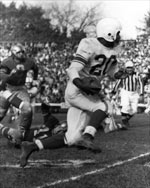 George Taliaferro |
CONTENTS
